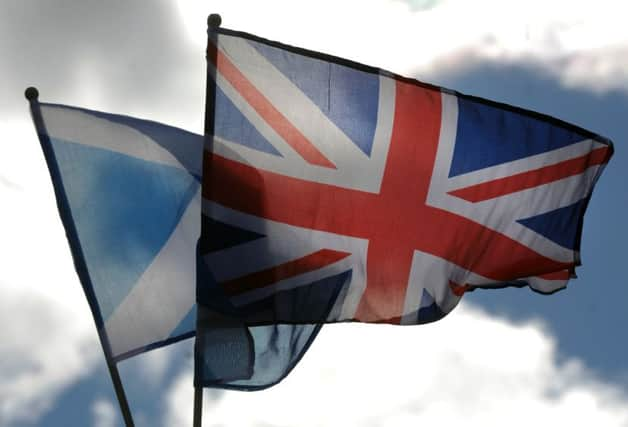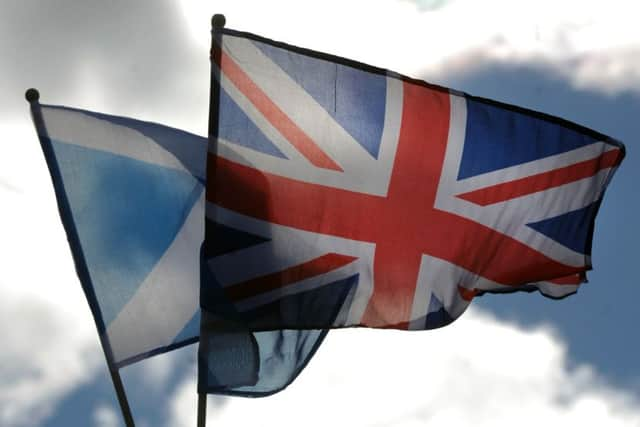Scottish independence: Yes/No argue fiscal cases


Alex Salmond claimed that each Scot could be in line for a £1,000 per year “independence bonus” in 15 years’ time.
The First Minister said his bonus would feature strongly in the Yes campaign in the run-up to the 18 September referendum.
Advertisement
Hide AdAdvertisement
Hide AdHe said his argument was based on using the powers of independence to boost growth and employment as well as attracting 24,000 immigrants to Scotland per year.


The Scottish Government’s economic case was outlined to counter claims from Whitehall that every Scot is £1,400 better off per year because the country is part of the United Kingdom.
The £1,400 “UK dividend” – calculated by the Treasury in an effort to distil the economic benefits of the Union into a single figure – came in a 77-page UK government document launched by Chief Secretary to the Treasury Danny Alexander at a press conference in Edinburgh.
According to the document, Scotland analysis: Fiscal policy and sustainability, the dividend quantifies how much richer every man, woman and child in Scotland will be due to the lower taxes and sustained public services achieved through the country being part of the UK.
UK government officials claimed Scots would benefit from the £1,400 figure for the 20 years beyond 2016-17 – the first full year of independence, as proposed by the Scottish Government – and was the equivalent of £150 billion over the period.
Mr Alexander claimed that an independent Scotland would have to offset that dividend by either cutting public spending or increasing income tax from 20 per cent to 28 per cent, VAT from 20 per cent to 26 per cent, and increasing duty on alcohol, tobacco and fuel by 40 per cent.
The “uncosted” policies of the Scottish Government, such as reducing corporation tax to 3 per cent below the UK rate and increased childcare provision, were also taken into account in the Treasury’s calculations, as were the savings made from a lower defence budget and not contributing to the cost of the Trident replacement.
The Treasury paper, which was compiled over the past 18 months, also took into account higher interest payments on government debt after independence, declining oil revenues and an ageing population.
Advertisement
Hide AdAdvertisement
Hide AdMr Alexander said it had been calculated that the Scottish Government’s new policies would cost at least £1.6bn each year.
The Office for Budget Responsibility had forecast that oil and gas revenues will fall by 95 per cent as a share of GDP over the next 20 years.
The proportion of elderly people in Scotland – which has a population ageing more rapidly than elsewhere in the UK – would see the number of Scottish pensioners increase from one million to 1.3 million over the next two decades.
An hour before Mr Alexander unveiled his document yesterday morning, Mr Salmond revealed the Scottish Government’s 48-page document Outlook for Scotland’s Public Finances and the Opportunities for Independence.
It claimed an independent Scotland could be £5bn a year better off in 15 years’ time without having to raise taxes.
Mr Salmond said his government’s paper gave “a very clear picture of what independence could deliver in economic terms for the people of Scotland”.
An increase of 0.3 percentage points in productivity growth rate over the long term could raise an additional £2.4bn a year in revenues by 2029-30, according to the report.
Meanwhile, upping the employment rate in Scotland by 3.3 percentage points – taking it to the level of the five best-performing countries in the developed world – could provide additional revenues of £1.3bn a year. And a rise in the population – which is less than the UK as a whole is expected to see – could net a further £1.5bn a year by 2029-30, it argued.
Advertisement
Hide AdAdvertisement
Hide AdThe total “bonus” would be worth about £1,000 for every person in Scotland, Mr Salmond said.
He added: “We describe that as the bonus of independence. Not caused by increase in taxes, but by increase in productivity, increase in the working age population and an increase in employment.”
On his plans to increase the Scottish population by 6.2 per cent by 2029-30, Mr Salmond said average inward net migration was 22,000 in each of the past ten years.
“I think to increase the working-age population through net migration of 2,000 additional a year compared to experience of the last ten years is an entirely reasonable prospective, and is very realistic to achieve,” the First Minister said.
HM Treasury v Scottish Government
As claim and counter-claim fly over who will leave Scottish families better off, Political Editor Tom Peterkin details the competing visions
UK DIVIDEND VERSUS INDEPENDENCE BONUS
The UK government claims there is a “UK dividend” worth £1,400 per person per year for the 20 years after 2016-17, resulting from lower tax and sustained public services that accrue from remaining part of the United Kingdom.
The Scottish Government argues that Scots would each receive an “independence bonus” of £1,000 per year within 15 years of the country leaving the UK.
This is based on the assumption that there would be a 0.3 percentage point increase in the long-term productivity growth rate, which could see tax revenues increase by £2.4 billion a year by 2029-30. There would also have to be an increase in the employment rate of 3.3 points to increase revenues by £1.3bn over the same period. Increasing population could increase revenues by £1.5bn a year by 2029-30.
Advertisement
Hide AdAdvertisement
Hide AdAfter 13 years, that would amount to tax receipts being boosted by £5bn a year – a figure that translates to £1,000 per individual.
NORTH SEA OIL
The Treasury paper quotes the latest Office for Budget Responsibility figures which forecast that oil and gas revenues remain stable at about £3.5bn per year from 2014-15 to 2018-19. That compares with the £11.3bn in 2011-12.
It states that if North Sea money is divided on geographic terms, additional tax revenue has been broadly equivalent to extra public spending in Scotland. It says: “Scotland’s fiscal position already relies on spending all of the revenues from a geographic share of the North Sea. So there would be no fiscal benefit from independence: the revenues cannot be spent twice. Instead, because the revenues from the North Sea have fallen sharply, but public spending has not, Scotland benefits from being part of the UK.”
The Scottish Government envisages a scenario based on its own Oil and Gas Analytical bulletin, published this month. It lists six scenarios, of which the third most optimistic (scenario 4) is used for the purposes of its report. Under that scenario, oil and gas revenues amount to £6.9 billion in 2016-17; £7.3bn in 2017-18; and £6bn in 2018-19.
The Scottish Government makes the case that the inclusion of a geographical share of North Sea receipts over the last five years has resulted in Scotland on average accounting for 9.5 per cent of UK tax receipts. On a per capita basis, annual tax receipts have averaged £10,000 over the past five years – £1,200 or 14 per cent per capita higher than in the UK as a whole.
GROWTH
The UK government forecasts that an independent Scotland starts a with total real GDP per capita around 10 per cent higher than in the rest of the UK – a difference driven by the assumption that Scotland would get a geographical share of oil output. It says that Scottish real GDP per capita would converge towards the UK level as offshore output declines.
Even taking that into account, the Treasury paper argues that growth in an independent Scotland would have to be more than 50 per cent higher on average every year over the first 20 years of independence to offset the debt gap from independence.
It says: “This would be greater than anything Austria, Belgium, Canada, Denmark, France, Finland, Germany, Italy Japan, the Netherlands, Norway, Sweden, Switzerland or the USA has achieved over the last 20 years.”
Advertisement
Hide AdAdvertisement
Hide AdThe Scottish Government claims that the powers of independence would be used to stimulate growth. Its paper says its preference is for growth of around 3 per cent between 2016-17 and 2018-19, which, it says, contrasts with the Treasury’s forecast of 1 per cent.
IMMIGRATION
The UK government paper says that increased immigration as a solution to long-term demographic challenges has “limitations”. The paper says: “Annual net immigration of 15,500 people per year is equivalent to adding a city of the population of Dundee every ten years which would bring significant challenges for an independent Scottish state.”
The Scottish Government claims that attracting skilled migrants would increase tax revenues. It envisages a scenario whereby Scotland increases its population by 6.2 per cent between 2018-19 and 2029-30 (a percentage which is below the 6.5 per cent increase envisaged for the UK as a whole). That would increase Scotland’s onshore revenues by around £1.5 billion in real terms by 2029-30.
In his press conference, Alex Salmond said he wanted to increase net inward migration from 22,000 per year to 24,000.
SET-UP COSTS OF INSTITUTIONS
The UK government document quotes research from the Institute for Government and the London School of Economics, suggesting that the average cost of a new policy department is about £15 million. It adds that incurring that cost for 180 new organisations after independence would come to £2.7 billion. However, it says £1.5bn is a “favourable estimate”, a figure based on academic research carried out on the Quebec model.
The Scottish Government has strongly disputed the Treasury’s claims on this – a stance that has been backed by the academics behind the research upon which the costs were worked out. But John Swinney was unable to say how much starting a new state would cost, despite being asked 11 times on the BBC yesterday morning. Mr Salmond later said that it would cost £250 million.
SEE ALSO